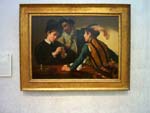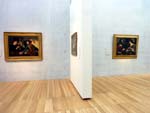
|

|
|
Home Site Search Contact Us Subscribe
|
|
|
What is "Quiet Design" and Why Should It Matter? Some Troubling Queries for Cathleen McGuigan and Sundry Fans of "Architectural Quietism" Can great architecture be so subdued that we remain unconscious of even experiencing it as architecture? By Norman Weinstein January 24, 2014
Editor’s note: This is in response to Architectural Record Editor-in-Chief Cathleen McGuigan’s "Shouting the Praises of Quiet Design," January 2014.
Dear Cathleen:
Trust that my dismay over your praise of Renzo Piano’s addition to Louis Kahn’s Kimbell Art Museum for exemplifying “quiet design” is not a simple annoyance over an arguably useless phrase. The vagueness of “quiet design” intensely bothers me, as it might other readers, because it acts as a smoke screen obscuring several crucial architectural issues. In fact, I share with you admiration for Piano’s addition – but I would hate to think my approval of Piano’s design has anything to do with your sense of “quiet design.” Or lends support to what may possibly be Piano’s disingenuous and intellectually shallow explanation for his design. Since architectural discourse is so riddled with phrases meaning little to nothing, I’ve decided to start a one-man campaign to see if architecture can be discussed more deeply once bogus language is trimmed. So that is why I’m writing to you about this matter.
I’m guessing you’re implying “quiet design” means design that is subdued, unselfconscious, muted, unshowy, Apollonian-harmonious rather than Dionysus-dizzying. That makes me wonder: Can great architecture be so subdued that we remain unconscious of even experiencing it as architecture? Perhaps. This gets tricky however. If I’m seeking a multi-faceted experience in an art museum – and who wouldn’t? – don’t I want a constant dialectically dynamic awareness of encountering deeply meaningful art and architecture simultaneously. When I’ve experienced art in Kahn’s museums, I’ve never lost consciousness of Kahn’s intense presence in my mind, as monumentally present and alive as the artistic masterpieces hanging in the galleries he designed. Can anyone experience the Guggenheim’s collection without a strong sense of Frank Lloyd Wright’s boisterous presence constantly shaping the nature of the experience of beholding art there?
So why is architectural quietness necessarily a virtue? What differentiates it clearly from innocuousness, or simply boilerplate mediocrity, that we’ve all likely experienced in numerous art museums and their additions, not to mention other humdrum structures?
Your alignment of Piano’s “quiet addition” and Herzog & de Meuron’s Perez Art Museum (PAM) is equally puzzling. While classifying the architecture and not the art of the PAM as the compelling attraction – a comment I’m certain Miami museumgoers will adore you for making – you somehow link these radically different art museums by their “potential for rich experiences, an under-rated value in a world that privileges innovative form” Are you implying that art museums that foreground innovative architectural form – let’s consider Frank Gehry’s Guggenheim Museum Bilbao – somehow necessarily lessen rich experiences of both art and architecture simultaneously? If so, how and why?
Implicit in your argument for what is “architectural quietism” seems a set of blanket generalizations about a myriad of different kinds of art and architecture appreciators. Take your example of how Piano’s “sublimely refined concrete gallery walls, all silvery-gray silkiness” refreshed your appreciation of Caravaggio’s painting “The Cardsharps.” That same Caravaggio painting sparkles on my computer monitor as I write. With no guided frame. With no sublime refined concrete wall behind it. No wash of soft Fort Worth light caressing it. Every time I see a Caravaggio painting in any architectural context it is changing constantly within vision. Hooray that Piano’s Kimbell Museum addition rejuvenated your Caravaggio encounter – but I wouldn’t assume that Piano’s architecture was necessarily the cause of your fresh vision of Caravaggio’s masterpiece. How would you even begin to make a tight case for “evidence-based” art museum design?
Perhaps Renzo Piano’s remark that, “Like a movie, a building is a simple thing – you go home with one good, clear emotion” is a statement disclosing designer profundity in that regard rather than a shockingly flip, hence sensationally repeatable, sound-bite. But it is somewhat obfuscated by Piano’s claim of “readdressing Kahn.” Did Piano assume we had somehow lost touch with the grandeur of Kahn’s Kimbell until Piano’s addition “readdressed” it via the lens of his reflecting pool? Was Piano’s addition intended to return us to some supposed “one good, clear emotion” Kahn wanted us to experience? Do you really think Kahn believed a building is a simple thing intended to evoke a single feeling? Do you look to architecture for such a singular emotional reward? Looking at architecture long and hard as it unfolds, and evokes a richly symphonic spectrum of emotions and thoughts in dynamic evolving interplay. . . that is my emotional and intellectual reward. Why settle for anything less?
Feelings aside for the moment, what standards should we consider for additions to museums already widely recognized as architectural masterpieces? What kind of architect would, in some manner, not have “a dialogue with the venerable museum.” That sets the bar of achievement low. How can we discuss the quality of dialogue between an addition and venerable architecture it is in relation to? Can a successful addition be as boldly brash as the original it adds on to, or more so? Why does it have to be shy and modestly deferential to the original architecture? Why must refined understatement be trumpeted (ironic!) as a crowning virtue? Who profits most from architectural understatement crossing into blandness? When might “tasteful quiet design” become a clever verbal maneuver to dodge the reality of an architect’s dearth of imaginative daring and new ideas?
Perhaps Caravaggio’s painting portraying cheating at cards was a tale of what-you-see-you-don’t-get, an image that could be interpreted allegorically as overcoming faddish cycles of taste in art and architecture through an aesthetic sleight of hand on the part of the artist. Might the formal innovator need to be tricky, even cheat in some manner, to defeat the rigid forces defending oh so tastefully understated, often innocuous conventional taste?
A world that privileges innovative architectural forms for their own sake sounds intriguing. One might need to set a GPS to another solar system to locate it, however. The world I live in seems heavily in the hands of political and financial power brokers with rather subdued and conservative taste in the arts and architecture. And their developers of choice have, at best, a very mixed record demonstrating favoritism toward radical innovative forms. You need not look far to comprehend how the Bauhaus didn’t make it to my house, or to Tom Wolfe’s for that matter. For some of us, revolutions in architectural form (which need not exclude bowing whenever apt to our artistic ancestors) are exquisite gateways to new multi-form experiences laced with beguiling and life-enhancing complexity. In sotto or fortissimo registers, architecture and art contribute shocks and shouts of recognition characterizing being deeply alive, and fully responsive, to a rapidly changing world that seems everything but unified, simple, subdued, and pure.
Your response would be welcome.
Sincerely, Norman Weinstein
Norman Weinstein writes about architecture and design for Architectural Record, and is the author of “Words That Build” – an exclusive 21-part series published by ArchNewsNow.com – that focuses on the overlooked foundations of architecture: oral and written communication. He consults with architects and engineers interested in communicating more profitably; his webinars are available from ExecSense. He can be reached at nweinstein@q.com.
More by Weinstein:
An exclusive 21-part series that focuses on the overlooked foundations of architecture: oral and written communication.
Weinstein: From Ada to Zaha and Everything In Between Op-eds, book reviews, musings, and debate. |
(click on pictures to enlarge)  Lee Rosenbaum Caravaggio's "The Cardsharps" (c. 1595) in the Kimbell Museum’s Piano Pavilion  Lee Rosenbaum Caravaggio's "The Cardsharps (left), and Guercino's "Christ and the Woman of Samaria" (c. 1619-20) |
© 2014 ArchNewsNow.com